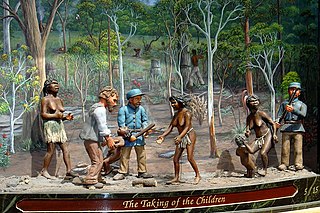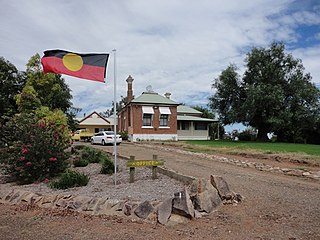
The Stolen Generations were the children of Australian Aboriginal and Torres Strait Islander descent who were removed from their families by the Australian federal and state government agencies and church missions, under acts of their respective parliaments. The removals of those referred to as "half-caste" children were conducted in the period between approximately 1905 and 1967, although in some places mixed-race children were still being taken into the 1970s.

The second question of the 1967 Australian referendum of 27 May 1967, called by the Holt government, related to Indigenous Australians. Voters were asked whether to give the Commonwealth Parliament the power to make special laws for Indigenous Australians in states, and whether Indigenous Australians should be included in official population counts for constitutional purposes. The term "the Aboriginal Race" was used in the question.
Aboriginal Protection Board, also known as Aborigines Protection Board, Board for the Protection of Aborigines, Aborigines Welfare Board, and similar names, refers to a number of historical Australian state-run institutions with the function of regulating the lives of Aboriginal Australians. They were also responsible for administering the various half-caste acts where these existed and had a key role in the Stolen Generations. The boards had nearly ultimate control over Aboriginal people's lives.
The Australian colonies and in the nineteenth century created offices involved in dealing with indigenous people in the jurisdictions.

The Aboriginals Protection and Restriction of the Sale of Opium Act 1897(Qld), was an Act of the Parliament of Queensland. It was the first instrument of separate legal control over Aboriginal peoples, and was more restrictive than any contemporary legislation operating in other states. It also implemented the creation of Aboriginal reserves to control the dwelling places and movement of the people.
Aboriginal Affairs NSW (AANSW) is an agency of the Premier's Department in the Government of New South Wales. Aboriginal Affairs NSW is responsible for administering legislation in relation to the NSW Government policies that support Indigenous Australians in New South Wales, and for advising the Minister for Aboriginal Affairs and Treaty, David Harris.

Half-Caste Act was the common name given to Acts of Parliament passed in Victoria and Western Australia in 1886. They became the model for legislation to control Aboriginal people throughout Australia - Queensland's Aboriginals Protection and Restriction of the Sale of Opium Act 1897, NSW/ACT's Aboriginal Protection Act 1909, the Northern Territory Aboriginals Act 1910, South Australia's Aborigines Act 1911, and Tasmania's Cape Barren Island Reserve Act 1912.
Adoption in Australia deals with the adoption process in the various parts of Australia, whereby a person assumes or acquires the permanent, legal status of parenthood in relation to a child under the age of 18 in place of the child's birth or biological parents. Australia classifies adoptions as local adoptions, and intercountry adoptions. Known child adoptions are a form of local adoptions.
Commonwealth, State, and Territory Parliaments of Australia have passed Aboriginal land rights legislation.
An Aboriginal reserve, also called simply reserve, was a government-sanctioned settlement for Aboriginal Australians, created under various state and federal legislation. Along with missions and other institutions, they were used from the 19th century to the 1960s to keep Aboriginal people separate from the white Australian population. The governments passed laws related to such reserves that gave them much power over all aspects of Aboriginal people’s lives.

The Cootamundra Domestic Training Home for Aboriginal Girls, commonly known as "Bimbadeen" and Cootamundra Girls' Home, located at Cootamundra, New South Wales, was a home and training college for Aboriginal girls during the 20th century. It operated by the NSW Government's Aborigines Welfare Board from 1911 to 1968 to provide training to girls forcibly taken from their families under the Aborigines Protection Act 1909. The only training received by the girls was to work as domestic servants, and they were not allowed any contact with their families. They were part of a cohort of Aboriginal people now known as the Stolen Generations.

Kinchela Aboriginal Boys' Training Home, also known as Kinchela Boys' Home and the Aboriginal Mission School, is a heritage-listed former Aboriginal Boys' Training Home at 2054 South West Rocks Road, Kinchela, Kempsey Shire, New South Wales, Australia. It was built from 1924 to 1970.

Bomaderry Aboriginal Children's Home is a heritage-listed former Institutional home for Aboriginal children and now Nowra Local Aboriginal Land Council offices at 59 Beinda Street, Bomaderry, in the South Coast region of New South Wales, Australia. It was designed by United Aborigines Mission and built from 1908. It was also known as Bomaderry Children's Home; Bomaderry Babies Home; and United Aborigines Mission Home. The property is owned by Nowra Local Aboriginal Land Council. It was added to the New South Wales State Heritage Register on 17 February 2012.
The Northern Territory Aboriginals Act 1910 was an Act of the South Australian parliament, assented to on 7 December 1910. The long name of the Act was "An Act to make Provision for the better Protection and Control of the Aboriginal Inhabitants of the Northern Territory, and for other purposes", and it established the Northern Territory Aboriginals Department and created the office of Chief Protector of Aborigines. On 1 January 1911, the Northern Territory was transferred from South Australia to federal government control. The 1910 Act was repealed by the federal government's Aboriginals Ordinance 1918 on 13 June 1918, which nevertheless carried forward many of the provisions of the 1910 Act. A 1939 amendment replaced the position of Chief Protector with Director of Native Affairs.

The Aborigines Protection Act 1909 (NSW) was an Act of the Parliament of New South Wales that repealed the Supply of Liquors to Aborigines Prevention Act 1867, with the aim of providing for the paternalistic protection and care of Aboriginal people in New South Wales. The originating bill was introduced to Parliament in the same year it was enacted, and was the first piece of legislation that dealt specifically with Aboriginals in the State.

The Aboriginal Land Rights Act 1983(NSW) is an Act of the Parliament of New South Wales which was enacted to return land to Aboriginal peoples through a process of lodging claims for certain Crown lands and the establishment of Aboriginal Land Councils. The Act repealed the Aborigines Act 1969. The originating bill was introduced in the same year it was enacted.
The Aborigines Welfare Directorate was a government agency which operated in New South Wales from 1969 to 1975. It had wide-ranging responsibilities over the lives of Aboriginal people.
The Aboriginal-Australian Fellowship (AAF) was a Sydney-based organisation focused on changing the New South Wales Aborigines Protection Board, the wider issues of wage parity and full citizenship for Aboriginal Australians.








